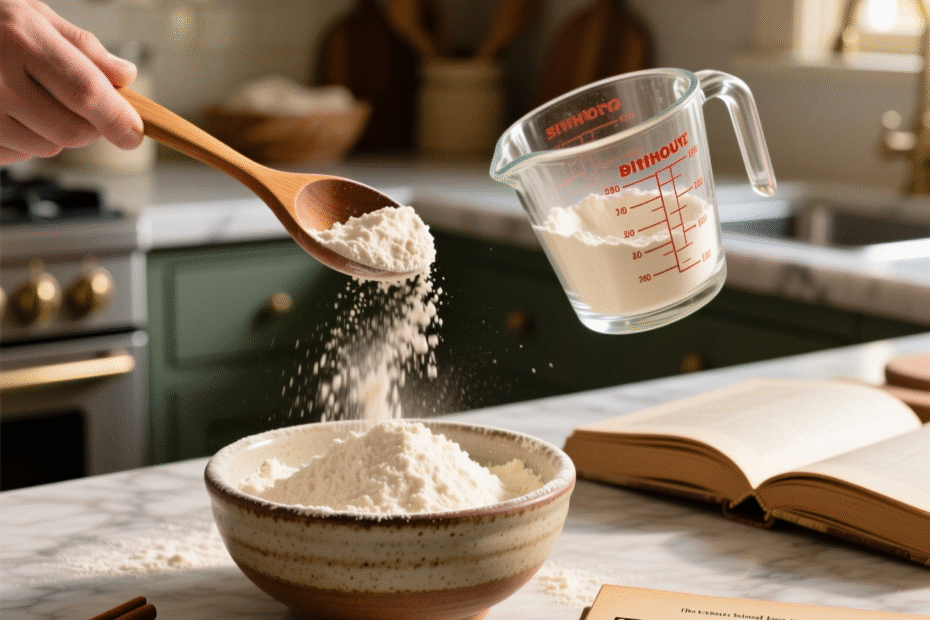Have you ever followed a baking recipe to the letter—only to end up with dry, crumbly cookies or a cake that refuses to rise? Chances are, the culprit wasn’t your oven or your mixing technique. It was how you measured your flour. Unlike liquids, flour is deceptively tricky to measure accurately without a kitchen scale.
Scoop it straight from the bag, and you might pack in 25% more than the recipe calls for. Fluff it too much, and your batter could turn watery.
In this article, we’ll explore the right way to measure flour without a scale—a skill that can transform your baking from inconsistent to reliably delicious. You’ll learn why accurate flour measurement matters, discover the industry-standard “spoon-and-level” method, avoid common mistakes, and even pick up clever hacks using household items.
Whether you’re a weekend baker or just trying to nail your grandmother’s biscuit recipe, mastering this simple technique will save you time, ingredients, and frustration. Let’s dive in and uncover how a small change in how you scoop flour can lead to big improvements in your baked goods.
Why Measuring Flour Accurately Matters More Than You Think
Baking is often described as a science—and for good reason. Unlike cooking, where you can adjust seasonings or textures as you go, baking relies on precise chemical reactions. Too much flour, and your cookies spread less and turn tough. Too little, and your bread collapses or your muffins become gummy.
Here’s a striking fact: a single cup of all-purpose flour can weigh anywhere from 100 to 160 grams, depending on how it’s measured. That’s a 60% variance—enough to ruin even the most carefully written recipe. Professional bakers and food scientists almost universally recommend using a digital kitchen scale because weight is consistent; volume is not. But what if you don’t own a scale? That’s where technique becomes your best ally.
Consider this: two home bakers follow the same chocolate chip cookie recipe. One scoops flour directly from the bag with a measuring cup, packing it down slightly. The other uses the spoon-and-level method (more on that soon). The first batch turns out dense and dry; the second is golden, chewy, and perfectly textured. Same ingredients, same oven—just a different measuring approach.
Understanding this variability isn’t about perfectionism—it’s about respecting the balance of ingredients that makes baking work. And the good news? You don’t need fancy tools to get it right.
The Gold Standard: The Spoon-and-Level Method
If you take away only one tip from this article, let it be this: always use the spoon-and-level method when measuring flour without a scale. This technique is endorsed by culinary schools, cookbook authors, and test kitchens like King Arthur Baking Company and America’s Test Kitchen. Here’s how it works:
- Fluff the flour in its container with a spoon or fork. Flour settles and compacts over time, especially in bags or bins. Fluffing reintroduces air and ensures a lighter, more accurate measure.
- Use a spoon (not the measuring cup!) to gently scoop flour into your dry measuring cup. Don’t pack it down or shake the cup—just let the flour fall in naturally.
- Level off the excess with the straight edge of a knife or bench scraper. Run it across the top of the cup so the flour is perfectly flush with the rim.
This method consistently yields about 120–125 grams of all-purpose flour per cup, which aligns with most modern U.S. recipes. Compare that to the “dip-and-sweep” method (where you plunge the cup directly into the flour bin), which can give you 140–160 grams—a massive difference in baking terms.
Why does this matter? Think of flour as the skeleton of your baked goods. Too much, and you overpower the leavening agents (like baking powder or yeast). Too little, and there’s not enough structure to hold everything together. The spoon-and-level method strikes that delicate balance, giving you repeatable results every time.
And don’t worry—it only takes a few extra seconds. Once it becomes habit, you’ll wonder why you ever measured flour any other way.
Common Mistakes (and How to Avoid Them)
Even with good intentions, many home bakers unknowingly sabotage their recipes through simple measuring errors. Let’s look at the most frequent pitfalls—and how to sidestep them.
Mistake #1: Scooping flour directly from the bag or bin
This is the #1 error. When you dip your measuring cup into a flour container, you compress the flour, especially if you tap the cup on the counter to “settle” it. Result? Up to 30% more flour than intended.
Fix: Always fluff first, then spoon. Treat flour like delicate snow—not like sand you’re shoveling.
Mistake #2: Using liquid measuring cups for flour
Liquid measuring cups are designed for pouring and have extra space at the top. They’re not meant for dry ingredients. Trying to level flour in a spouted glass cup is messy and inaccurate.
Fix: Use dry measuring cups—those nested metal or plastic cups that come in standard sizes (¼, ⅓, ½, 1 cup). They’re designed to be filled to the brim and leveled cleanly.
Mistake #3: Shaking or tapping the cup to “pack” the flour
Some bakers think this ensures consistency. In reality, it mimics the density of packed brown sugar—which flour should never be.
Fix: Resist the urge to tap. If the flour looks slightly mounded after spooning, that’s fine. Just level it off gently.
Mistake #4: Storing flour in a way that causes compaction
Keeping flour in a tightly sealed container that’s frequently jostled (like a crowded pantry shelf) can cause it to settle and harden over time.
Fix: Store flour in an airtight container, but give it a quick fluff before each use. Better yet, transfer it to a wide-mouth jar where it’s easier to access and aerate.
By avoiding these errors, you’ll get closer to the recipe developer’s intended outcome—without ever touching a scale.
Clever Hacks for Measuring Flour Without Standard Tools
What if you’re in a pinch—maybe you’re baking at a friend’s house, camping, or your measuring cups are in the dishwasher? Don’t panic. With a little creativity, you can still measure flour reasonably well using everyday items.
Hack #1: Use a standard coffee mug (with caution)
While not precise, a typical 8-ounce coffee mug holds roughly 1½ cups of loosely spooned flour. If your recipe calls for 3 cups, fill it twice—but remember to fluff and level as best you can. This isn’t ideal for delicate pastries, but it works for rustic breads or pancakes.
Hack #2: Measure with tablespoons
One cup of flour equals 16 tablespoons. If you have a standard tablespoon (not a soup spoon!), you can count out 16 level spoonfuls. It’s tedious, but surprisingly accurate if done carefully.
Hack #3: Use a kitchen ladle or small bowl as a reference
If you’ve baked before and know how much flour fits in your favorite mixing bowl or ladle, you can use it as a rough guide. For example, if your bowl usually holds 4 cups for a bread recipe, you can estimate portions from there.
Hack #4: The “handful” method (for forgiving recipes)
For recipes like flatbreads, dumplings, or drop biscuits, exact flour amounts matter less. In these cases, add flour gradually until the dough reaches the right consistency—soft but not sticky. Trust your hands over the measuring cup.
Keep in mind: these hacks are emergency solutions, not replacements for proper technique. But they prove that baking is adaptable—and that understanding why measurements matter is more valuable than rigidly following numbers.
Why This Skill Transforms Your Baking (and Saves You Money)
Mastering flour measurement isn’t just about perfect pastries—it’s about confidence, efficiency, and even sustainability.
When your cakes rise evenly and your pie crusts stay flaky, you’re less likely to toss failed batches in the trash. That means less food waste and fewer trips to the store for replacement ingredients. Over time, those savings add up.
More importantly, accurate measuring builds baking intuition. Once you understand how flour behaves, you’ll start noticing patterns: “This dough feels too stiff—maybe I added too much flour,” or “These cookies spread too much—perhaps I under-measured.” You become an active participant in the process, not just a recipe follower.
Plus, consider the emotional payoff. There’s genuine joy in pulling a golden loaf of bread from the oven or serving cookies that disappear in minutes—all because you took 10 extra seconds to measure correctly. Baking becomes less stressful and more rewarding.
And let’s not forget: sharing reliable results builds your reputation. Friends will ask for your recipes. Family will request your desserts for holidays. All because you learned the right way to measure flour.
Conclusion
Measuring flour without a scale might seem like a minor detail, but as we’ve seen, it’s one of the most impactful habits you can adopt in your kitchen. By using the spoon-and-level method, avoiding common mistakes, and understanding why accuracy matters, you’ll achieve consistently better results—whether you’re making banana bread, pizza dough, or holiday cookies.
Remember: baking isn’t about perfection; it’s about reproducibility and respect for ingredients. Flour may look like a humble pantry staple, but it’s the backbone of countless recipes. Treat it with care, and it will reward you with texture, structure, and flavor.
So next time you reach for that bag of flour, pause for a moment. Fluff it, spoon it, level it—and bake with confidence. Your future self (and your taste buds) will thank you.
Now it’s your turn: Have you ever had a baking fail that turned out to be a measuring mistake? Or do you swear by your own flour-measuring trick? Share your story in the comments below—we’d love to hear from you! And if this guide helped you, don’t forget to share it with a fellow baker who’s still scooping flour straight from the bag. Happy baking!

Thayná Alves is an influential digital content creator who has carved out a significant space in the realms of technology, finance, and entrepreneurship. Through her blog, Newbacker.com , she stands out as an authentic and accessible voice for individuals seeking practical information about investments, innovation, and emerging trends in the financial market.
